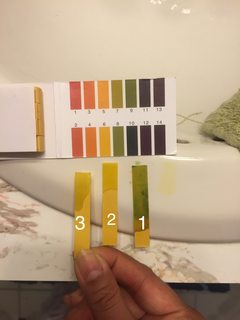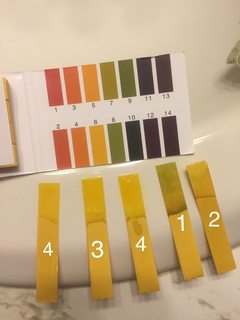So, as we all know, we have a lot of time on our hands when we use a sheet mask. As a result, I got curious about the pH of the two cleansers I had used most recently, Innisfree Jeju Bija Anti-Trouble Gel Cleanser and CosRX Low pH Good Morning Gel Cleanser. There’s been a lot of talk about how lower pH cleansers are better for your skin because the low pH can be good for actives and low pH helps protect your skin barrier. Why do I keep referencing Snow White and the Asian Pear’s blog post? Because it’s an excellent summary of why low pH is good for the skin and I’m not going to repeat what’s already been said well and clearly.
The chemist in me insists on clarifying what “low pH” means in the context of skincare. Skin’s natural pH likes to hover around 5.5, while water is more or less at a pH of 7. Because most soaps are made using incredibly basic ingredients, they tend to have a high pH like 8. Low pH cleansers that are good for the skin tend to be around 5.5 pH because it means your skin doesn’t work as hard to maintain that pH of 5.5. Every time you wash your skin, you’re exposing it to the pH 7 of water and the pH of your cleanser and your skin has to do work to maintain its natural pH.
(For the record, low pH to me means shit that causes chemical burns. I learned the hard way to stop wearing my favorite shirts to lab whenever I needed to prepare a pH buffered solution. The shit you use to adjust pH are extreme pH levels such as pH 1 and pH 10. They’re not nice, and that’s why safety gear gets so damned hyped in lab. I can’t tell you how many times I thought I was fine, came home, did the laundry, and found new acid holes in my favorite shirts because I didn’t see the minuscule spatter land on me in lab. To me, low pH means something completely different than in the context of skincare. Learn from me. Don’t wear your favorite shirts to lab.)
Embarrassing science stories aside, I decided to use my handy dandy pH test strips to test the pH of the cleansers. The results surprised me quite a bit, as the following pictures will show. All photos were taken between 1 to 5 minutes after they were dipped in whatever test solution I used.
Here’s the first test of the Innisfree Jeju Bija Anti-Trouble Cleansing Gel.

- = Control test strip using tap water. As expected, it showed roughly a pH of 7
- = pH test strip of 2 drops of the cleansing gel fresh out of the bottle. According to the indicator, it reads roughly a pH of 5.5
- = pH test strip of the cleansing gel mixed with water on the palm of my hand simulating what the pH conditions would be if I could get a test strip cleanly on my face. It roughly reads a pH of 5 to 6, or the same as 2.
Now, these results surprised me because I’d read different posts that measured the Innisfree cleansing gel at a pH of 3. This is clearly not what I got. Also, I was not about to wash my face 3 or 4 times in a row in the name of science, so I washed my hand instead. Not to mention, I am incredibly, horribly, terribly near sighted. Seriously, I can’t see further than 3 inches or 7.5 cm clearly. In the state of Texas, I’d be legally blind without my glasses. The thought of trying to wash my face, get a teensy, tinsy test strip near my cheek without getting water/cleansing gel solution mixed with water all over it while I can barely see, seemed like a terrible plan. So we’re going to have to live with the results of me soaping my hands. I was so astounded at the results NOT being anywhere close to a pH of 3 that I had to try again.

- = Water Control Test Strip. Unsurprising pH of 7
- = 90% Isopropyl Alcohol Solution Test Strip. Expected pH below 7, maybe a pH of 6 or 5 at lowest. At least I know my test strips work (For those not remembering chemistry, alcohols form weak acid solutions.)
- = Test strip of Innisfree Cleansing Gel straight out of the bottle. pH roughly 5-6
- = Test strips of Innisfree Cleansing gel mixed with water on my hand. pH roughly 5-6
That was quite a surprise for me. I was hoping my test strips were wrong, because I really, really wanted Innisfree to be a low, low pH. Although, with that said, having worked with LOW LOW DANGER WILL ROBINSON DANGER DANGER pH solutions, do I really want to be using a cleanser whose pH is starting to approach the pH of the stuff I used to buffer solutions AND burned holes in my clothes? So maybe it’s not such a terrible thing that I only measured a pH of 5. I’d definitely waited long enough for the test strips to change colors (between 1 and 5 minutes) so it’s not like the solutions didn’t have enough time to react with the test strips. Now that my curiosity was thoroughly peaked, I had to know how CosRX’s low pH gel cleanser compared. Here’s the result.

- = Water Control Test Strip. Unsurprising pH of 7
- = 90% Isopropyl Alcohol Solution Test Strip. Expected pH below 7, maybe a pH of 6 or 5 at lowest.
- = Test strip of CosRX Low pH Good Morning Cleansing Gel straight out of the bottle, approximately 2-3 drops. pH roughly 5-6
- = Test strips of CosRX Low pH Good Morning Cleansing Gel mixed with water on my hand. pH roughly 5-6
Please note the extra droopy test strip at the left end. That was the strip that got mushed over my hand after I created soapy bubbles with the CosRX cleansing gel. The messy process reminded me why I was not attempting to measure this stuff on my face. From what I’ve read from the Asian Beauty subreddit the results for the CosRX cleasning gel are in line with what the company’s said about their product as well as the results of other at-home testers like myself. The end result? Both cleansers are about the same pH according to the handy dandy pH test strip results. On the back of the packet, the manufacturers are careful to note that pH results around 5.5 will look almost exactly the same color as the paper. So both cleansers are probably about a pH of 5.5 both on and off the skin.


Instructions are important. How the heck am I going to measure a pH that isn’t a visibly different color from the paper?
The more I thought about the disappointing results for the Innisfree cleanser, the more I realized I was measuring this all wrong. I would never, ever use these strips in a real lab environment if I needed a pH of 5.5 or lower. The reason I burned holes in all those shirts was because I was sitting in front of a pH meter from well-known chemistry instrument making companies like Cole Palmer and Mettler Toledo, carefully adding one drop of solution at a time to reach a desired pH. My lab manager, lab mates, and PI would have smothered their laughter while gently correcting me to use the pH meter instead of the test strips. If I absolutely had to use test strips, I’d use test strips that provided vivid color changes in the range that I needed. To understand what I’m talking about, we have to go back to some chem 101 and analytical chem.
So, the pH indicator strips actually have several indicator dyes on them that change colors in specific pH ranges, as you can see from this handy infographic from compoundchem.com. The actual indicator dyes responsible for the color change in the ranges of 4 to 7 aren’t all shown on the infographic, but they were probably methyl red (not pictured) and bromothymol blue. UC Davis has a wonderful chemistry wiki page that explains how indicator dyes work, how pH is calculated, and some great examples of extreme pH indicators. Or, as I fondly remember it, homework.
The reason I’m bringing up indicator dyes, is because I would never use a dye with a WIDE range of pHs to measure a small range of desired pH. If you notice on the infographic, phenol red has a pH range of 6.4 to 8. This would be great for measuring things around the pH of water. But, for wanting to know the pH of things around 3 to 6 – or where actives and skin pH resides, I’d need an indicator with a very different range. (Remember that blog post I keep talking about? Some forms of vitamin C work best at a pH of 3 to 4, some actives like BHAs are effective at pH of 4 or less. Go read it to get a better explanation of why skin pH and product pH matters. It’s important.) Think of it this way: measuring pH with universal indicator strips is like trying to cut model airplane pieces with a chain saw. Sure, it’ll cut things down to the general size, but the chain saw sucks at fine detail work. What I’d really need (short of access to a wet lab), is litmus paper that measures in the range that I need. The litmus paper to which I just linked measures pH in the range of 3 to 5.5 – or exactly what I need. When measuring pH with test strips, you want an indicator dye that
- works in the range you are measuring
- has vivid color changes in the range you are measuring
So, long story short, I’ve ordered $8 worth of test strip paper to repeat this exact same experiment all over again so I can really tell the difference between a pH of maybe 5.5 and a pH of 3, 4, or 5.5. The pH test strips that I have now are nice, but they’re a chain saw and I need an exacto blade.
No. I’m not buying a pH meter.
- They’re expensive.
- They require calibration.
- I have cats who don’t mean to destroy things, but they do it anyways.
- I don’t want to maintain the stock calibration solutions required to make sure a pH meter is accurate. This last bit is critical to maintaining the accuracy of pH meters and a pain in the butt. You have to either buy solutions that are independently certified pH solutions, or you have to make your own pH solutions and get them independently verified. Yeah. Not doing it if I’m not getting paid to do it.
I hope you enjoyed this breakdown on why chemistry and measuring things matters!
Citations Used:
The Colours and Chemistry of pH Indicators. Retrieved 2/19/2016. from http://www.compoundchem.com/2014/04/04/the-colours-chemistry-of-ph-indicators/
pH Indicators from UC Davis. Retrieved 2/19/2016 from Chemwiki. http://chemwiki.ucdavis.edu/Core/Physical_Chemistry/Acids_and_Bases/Case_Studies/Acid_and_Base_Indicators/PH_Indicators

Nice
LikeLike
I have no idea what you just said; yet, this was a thoroughly enjoyable read. 🙂
LikeLiked by 1 person
Well, at least I got one goal right – making science entertaining! 🙂
LikeLiked by 1 person
I’ve always checked the ph levels of my skincare products before buying and my skin has improved so much. Gotta love Korean skincare :’)
Please check out https://www.instagram.com/0.8liter_usa/ if you’re interested in receiving Korean beauty products for free in our weekly campaigns. We’re currently giving away CC cushions, but there are many more exciting products to come!
LikeLike